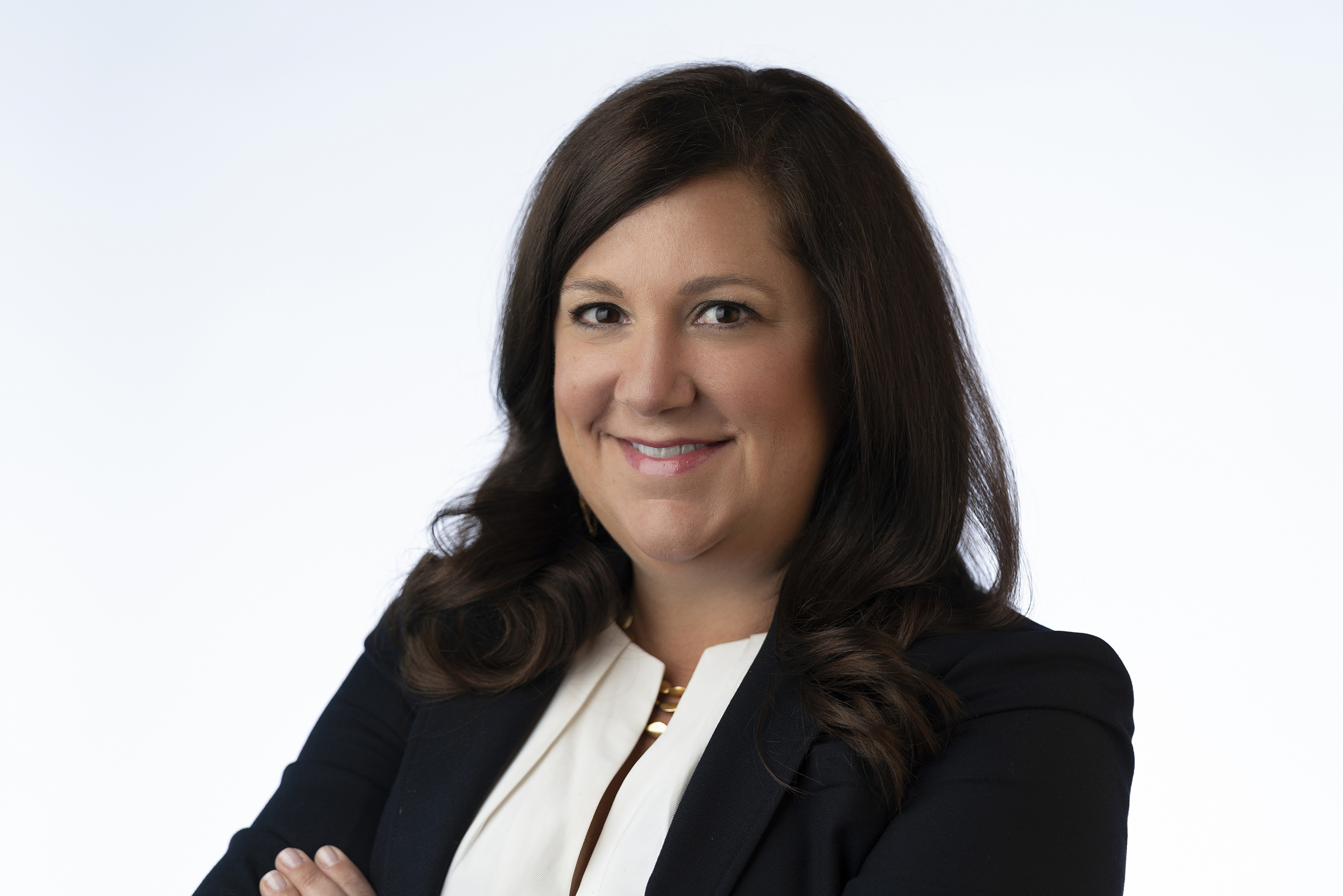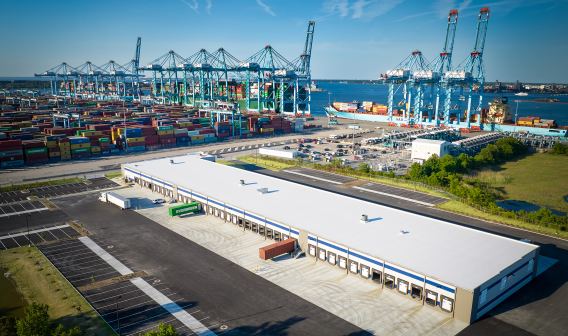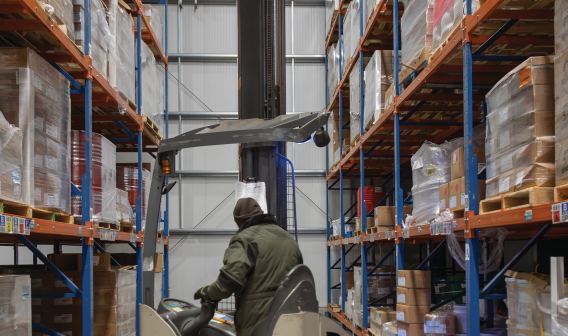We’ve invested more than $1 trillion across the U.S. since 2010 and now employ over 1 million people. I’m super proud of what we’ve also invested in Virginia, which, as you know, is a great place to do business, and where we are proud to have our second headquarters.
Since 2010, we’ve invested more than $109 billion in Virginia and employ over 39,000 folks. We continue to grow and invest. As I said, my focus is our transportation and delivery network. In order to deliver packages, our logistics network uses all modes of transportation. That includes ships, planes, trains, trucks, vans — even drones and bicycles.
Top of mind to me when you mentioned global issues are continued disruptions in the Red Sea, the Panama Canal drought and transit restrictions, and the recent tragic collapse of the Francis Scott Key Bridge in Baltimore, all of which have effects on supply chains. We work closely with our ocean carrier partners to pivot operations. That most often means moving volume to the West Coast to address issues with restrictions through the Panama Canal or moving our Baltimore-bound cargo to Newark or Norfolk, where we have ports and terminal operations that will allow us to handle that incremental volume in the meantime.
El Koubi: You mentioned you’ve just crossed the $100 billion number with your investments here in Virginia including, among other things, HQ2. We’re very proud to host you here in Virginia.
Let’s localize this for a minute. At the recent ribbon-cutting for your facility in Henrico County in Virginia, we learned several insights about your demand patterns, how you’re optimizing the network, and how you identified the need for that particular facility. Can you tell us a little bit about that process, the analytics, and how you ultimately come to a decision to invest in a particular facility as part of this global network?
de la Torre: We are proud to have opened our latest fulfillment center, which is what we call our distribution centers, our large warehouses. It’s a 2.7-million-sq.-ft. facility and the Commonwealth’s second Amazon Robotics Fulfillment Center. That means we have over 1,000 employees who are working side by side with our technology to deliver to customers.
Our fulfillment network consists of fulfillment centers, intermediate sorting centers, and then last-mile delivery stations. Previously, we had a nationwide network that was fulfilling orders across the United States, so if someone from Miami ordered something that was across the country, we would find a way to get it to Miami. We realized we might be able to do things more efficiently, make better use of our technology, and help drive down emissions if we restructured the network.
Instead of that national network, we restructured into eight regional networks. What that means now is more customer orders are being fulfilled from the fulfillment centers closer to them.
Before, the percentage of customer orders being fulfilled from the closest region was around 62%. The rest had to come from farther away. Now, with regionalization in place, we are able to fulfill 76% of customer orders from the region in which they’re located, which is a huge efficiency gain. We certainly expect that number to climb.
It also means that delivery speeds have improved because goods are traveling shorter distances and we’re seeing better truck utilization. That’s better for the environment, it’s better for our delivery speeds, and ultimately better for our customers.
El Koubi: You talked about this specific example in Henrico County. That had a lot to do with the particular configuration and demands within Amazon’s supply chain network. How is the broader supply chain ecosystem learning and adapting based on what you’re doing? How might other companies and industries follow a similar type of approach?
de la Torre: I can share with you a bit of the lessons we’ve learned. I don’t know that it’s particularly any secret sauce, but it has been successful for us.
As I mentioned, we found that fulfilling inventory closer to our customers reduces the distance packages travel, particularly in the middle mile. That’s trucking or aviation, which is the hardest segment to decarbonize, so anywhere we can reduce those stage lengths is a benefit all around. We also found that shorter routes make our network more conducive to introducing electric vehicles and other low-impact transportation modes.
El Koubi: What are you doing to improve supply chain visibility and glean different insights from the data to apply to demand planning, forecasting, and inventory management?
de la Torre: We’ve had to invest in a lot of technology and machine learning to help us determine inventory management so that we have the right stuff available for customers for two-day, and often less than two-day, delivery.
Our supply chain optimization technologies team is responsible for that. They work on some of the world’s most complex supply chain challenges, but at Amazon scale. They’re using data visualization to help understand customer buying patterns, to decide how much inventory to buy, and where to put it.
It’s dynamic, complex, and difficult to do, but the way I simplify it for my own purposes is, for example, stocking cold-weather items, like winter coats, where they’re most likely to be ordered in the northern states. We’re not putting a lot of snow shovels and winter coats in Miami when we know they’re going to be needs in the upper peninsula of Michigan.
It’s a super-simplified way of thinking about it, but that’s how our teams try to anticipate customer needs and place inventory appropriately. I would say, a vast majority of the time, we get it right.
I do, though, have one fun story to share. We were unprepared for a surge in demand that we didn’t anticipate. There’s a famous pop artist who started dating a famous NFL star, and this NFL star’s jersey…
El Koubi: I think I might know who you’re talking about.
de la Torre: …was stocked primarily in the Midwest, where the teams could reasonably expect orders for that jersey to come from. Once the news of their relationship started, we had orders for this jersey surge across the United States. We could have never predicted we would need Mr. Kelce’s jersey in every state in the country. That’s an example of where we certainly did not predict the surge.
El Koubi: What can non-consumer-focused companies glean about the ways you do material handling and physically move goods in a more cost-effective, safe way?
de la Torre: We spend a lot of time thinking about the customer, how we can make sure we’re anticipating their needs, and understanding what is going to remain constant over time. Rather than chasing trends, we think about what the customer will always want, which is the largest selection, the lowest prices, and the fastest delivery speeds. We continue to focus on that as our North Star and think about how we can make sure we’ve got the goods in place and the services that customers will want to meet those requirements.
El Koubi: How has technology transformed the way employees are working in the supply chain industry, both in terms of what it means for jobs, but also for the nature of the work itself?
de la Torre: Our newest Virginia facility is an Amazon Robotics facility. That means we have our associates working side by side with our robotics. We have found that the more technology we place in our operations, the more individuals we need to employ. Since we started including robotics in our facilities in 2012, we have created over a million jobs and also deployed more than 520,000 robotic drive units worldwide. It is really a symbiotic relationship where the more we embrace technology, the more we’re able to increase our ability to employ folks.
What I’ve also found is we’ve made our facilities safer, more efficient, and collaborative through robotics and advanced technologies like artificial intelligence, machine learning, and computer vision, for example. As we introduce technology and robotics into our operations, we need to train people for new work environments and new types of jobs. That’s one of the reasons we’ve invested in programs like Amazon Career Choice and our Mechatronics and Robotics Apprenticeship Program. We really do need to train our people in high-demand fields like robotics and software engineering.





